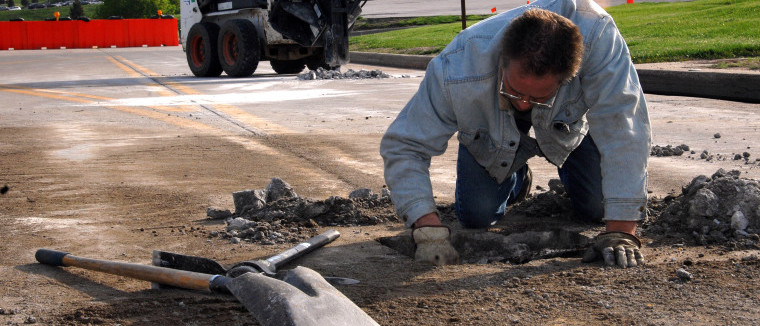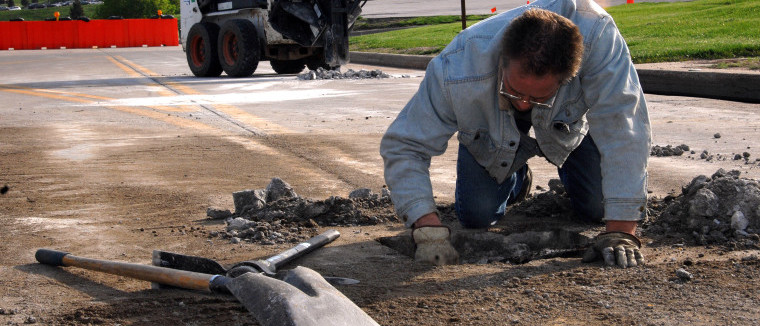
With winter’s end our annual spring tradition is upon us: I’m talking about pothole-palooza
Each year drivers, mass transit riders, and pedestrians are rattled, bounced around and inconvenienced by the seemingly larger number of potholes being formed in our aging roadways. This annual tradition is joined by a chorus of voices asking, “Where do my taxes go if they can’t even do something as simple as fix the roads?”
The truth is our taxes don’t go to roads, bridges, rail systems or other critical pieces of infrastructure anymore.
Just last month, Larry Summers, former Secretary of the Treasury said of infrastructure spending, “At this moment . . . the share of public investment in GDP, adjusting for depreciation, so that’s net share, is zero.” What’s more, two notable organizations recently ranked the United States’ infrastructure poorly:
- The American Society of Civil Engineers gives America’s infrastructure a D+
- The World Economic Forum ranks our infrastructure 12th among Developed Nations
Even comedian John Oliver recently got in on the act with a segment on his show, “This Week Tonight”.
While funny, the segment is spot on. We have reached the point where our infrastructure needs new investment or we risk significantly greater economic losses or more frighteningly, major catastrophes. Policymakers know we underinvest in our infrastructure, they know the conditions of our roads, bridges, and that our ports and water systems need dramatic new levels of investment, but they do not act.
For many the question becomes, ‘How do we begin to find the money in an atmosphere where voting for large scale spending projects and the revenues to fund them is anathema to a good portion of the electorate?”
Let’s be honest
We are talking about convincing Republicans that government financed infrastructure spending is necessary to maintain America’s economic strength. We don’t need to convince the Democrats because they’ll support any large scale spending project that comes down (the crumbling) roadway.
The current Chairman of the House Committee on Transportation and Infrastructure often makes the case that infrastructure development was a founding principle of the country. He is fond of noting that Adam Smith wrote in “The Wealth of Nations, that a central government is tasked with developing lanes of transportation to ‘provide merchants avenues for selling and trading commodities—all in the name of capitalism.’”
That hasn’t swayed Republicans. Neither have the multiple reminders that it was a Republican president who initiated the Interstate Highway System. Nor the reminders that President Ronald Reagan proposed a five-cent per gallon increase in the gas tax to fund infrastructure.
To achieve large scale infrastructure funding, a new strategy is needed that focuses on the following:
- At the most basic level, reluctant Members of Congress need to be convinced that this is not spending for consumption or transfer payments, but rather investment that supports and generates future economic growth. The more valid, third party studies flooding Congress about this, the better.
- This fight needs to be localized. Identify the district and town in which every one of the 63,207 structurally deficient bridges exists and tell voters about it. Tell them how local congestion can be alleviated and how roads can be improved. Tell them what it will mean in terms of jobs and quality of life. At the local level, these conversations take a different tenor. The reason is simple: an investment in another district is a pork barrel project. In my district it is an infrastructure improvement. Local resources need to put pressure on elected officials, at home, in their districts.
- It is important to unify the voices in favor of infrastructure spending. Who will motivate the voters; who will engage the media to carry the story? This must fall to the nation’s biggest trade associations representing business, construction, the largest employers, civil engineers and other specialty associations. They need to form a national coalition, divide the states up into regions and mobilize the grassroots and grasstops in targeted districts. They need to make the case to their local papers and broadcast outlets so that they editorialize on the need for investment.
The final point is this
Start now and don’t stop until there is a new President. Make this issue part of the 2016 campaign cycle. Go to the early primary states and force candidates to respond to questions at every campaign event. Make them develop detailed infrastructure investment plans and make them commit to addressing it in their first two years.
This will correspond with Rep. Bill Shuster’s last two years as Chairman of the House Transportation Committee, and it is clear he would like nothing better than to leave with a long-term, fully funded transportation and infrastructure investment bill attached to his chairmanship.
There were two great waves of infrastructure investment in America. The first was during the Great Depression and the second was during the 1950’s and 60’s when we built the interstate highway system. Since then, not much has happened. We haven’t built a major new airport since Denver’s, which was more than 20 years ago; the promise of high speed rail remains illusory; Americans spend more time each year commuting; and, businesses spend more time and money trying to get goods and services to consumers.
If we don’t act, if we can’t convince a well-defined group of legislators that investing in our infrastructure is vital to the commercial and national interests of our country, America doesn’t deserve to be the world’s driving economic force. Instead, we can sit by on our crumbling roads, unsound bridges and slow trains and watch other economies race by.
